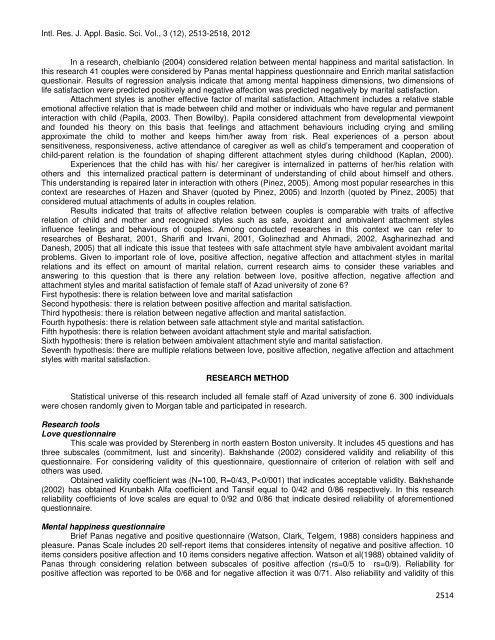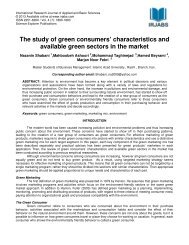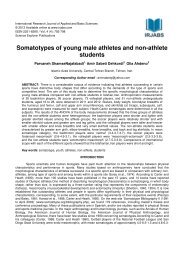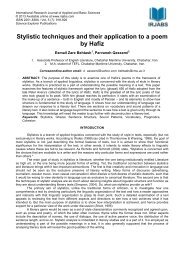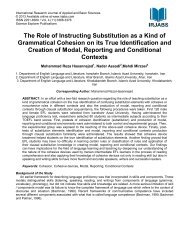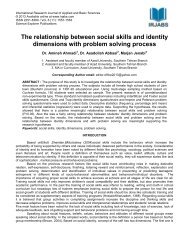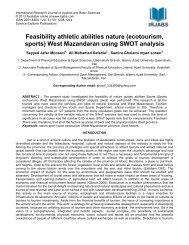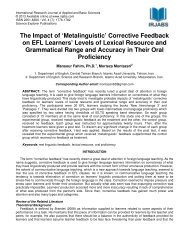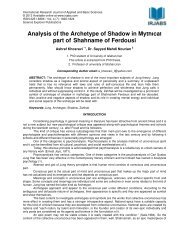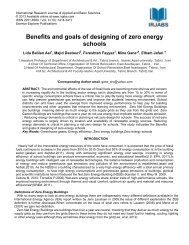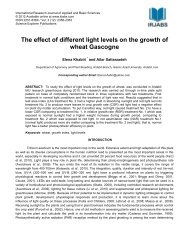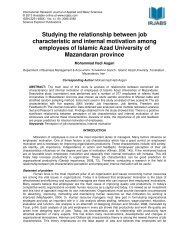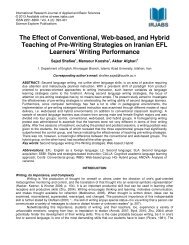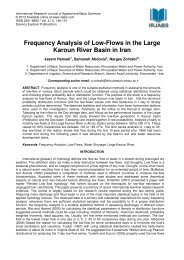Relation between love, positive affection, negative ... - irjabs.com
Relation between love, positive affection, negative ... - irjabs.com
Relation between love, positive affection, negative ... - irjabs.com
You also want an ePaper? Increase the reach of your titles
YUMPU automatically turns print PDFs into web optimized ePapers that Google loves.
Intl. Res. J. Appl. Basic. Sci. Vol., 3 (12), 2513-2518, 2012<br />
<br />
In a research, chelbianlo (2004) considered relation <strong>between</strong> mental happiness and marital satisfaction. In<br />
this research 41 couples were considered by Panas mental happiness questionnaire and Enrich marital satisfaction<br />
questionair. Results of regression analysis indicate that among mental happiness dimensions, two dimensions of<br />
life satisfaction were predicted <strong>positive</strong>ly and <strong>negative</strong> <strong>affection</strong> was predicted <strong>negative</strong>ly by marital satisfaction.<br />
Attachment styles is another effective factor of marital satisfaction. Attachment includes a relative stable<br />
emotional affective relation that is made <strong>between</strong> child and mother or individuals who have regular and permanent<br />
interaction with child (Papila, 2003. Then Bowilby). Papila considered attachment from developmental viewpoint<br />
and founded his theory on this basis that feelings and attachment behaviours including crying and smiling<br />
approximate the child to mother and keeps him/her away from risk. Real experiences of a person about<br />
sensitiveness, responsiveness, active attendance of caregiver as well as child’s temperament and cooperation of<br />
child-parent relation is the foundation of shaping different attachment styles during childhood (Kaplan, 2000).<br />
Experiences that the child has with his/ her caregiver is internalized in patterns of her/his relation with<br />
others and this internalized practical pattern is determinant of understanding of child about himself and others.<br />
This understanding is repaired later in interaction with others (Pinez, 2005). Among most popular researches in this<br />
context are researches of Hazen and Shaver (quoted by Pinez, 2005) and Inzorth (quoted by Pinez, 2005) that<br />
considered mutual attachments of adults in couples relation.<br />
Results indicated that traits of affective relation <strong>between</strong> couples is <strong>com</strong>parable with traits of affective<br />
relation of child and mother and recognized styles such as safe, avoidant and ambivalent attachment styles<br />
influence feelings and behaviours of couples. Among conducted researches in this context we can refer to<br />
researches of Besharat, 2001, Sharifi and Irvani, 2001, Golinezhad and Ahmadi, 2002, Asgharinezhad and<br />
Danesh, 2005) that all indicate this issue that testees with safe attachment style have ambivalent avoidant marital<br />
problems. Given to important role of <strong>love</strong>, <strong>positive</strong> <strong>affection</strong>, <strong>negative</strong> <strong>affection</strong> and attachment styles in marital<br />
relations and its effect on amount of marital relation, current research aims to consider these variables and<br />
answering to this question that is there any relation <strong>between</strong> <strong>love</strong>, <strong>positive</strong> <strong>affection</strong>, <strong>negative</strong> <strong>affection</strong> and<br />
attachment styles and marital satisfaction of female staff of Azad university of zone 6?<br />
First hypothesis: there is relation <strong>between</strong> <strong>love</strong> and marital satisfaction<br />
Second hypothesis: there is relation <strong>between</strong> <strong>positive</strong> <strong>affection</strong> and marital satisfaction.<br />
Third hypothesis: there is relation <strong>between</strong> <strong>negative</strong> <strong>affection</strong> and marital satisfaction.<br />
Fourth hypothesis: there is relation <strong>between</strong> safe attachment style and marital satisfaction.<br />
Fifth hypothesis: there is relation <strong>between</strong> avoidant attachment style and marital satisfaction.<br />
Sixth hypothesis: there is relation <strong>between</strong> ambivalent attachment style and marital satisfaction.<br />
Seventh hypothesis: there are multiple relations <strong>between</strong> <strong>love</strong>, <strong>positive</strong> <strong>affection</strong>, <strong>negative</strong> <strong>affection</strong> and attachment<br />
styles with marital satisfaction.<br />
RESEARCH METHOD<br />
Statistical universe of this research included all female staff of Azad university of zone 6. 300 individuals<br />
were chosen randomly given to Morgan table and participated in research.<br />
Research tools<br />
Love questionnaire<br />
This scale was provided by Sterenberg in north eastern Boston university. It includes 45 questions and has<br />
three subscales (<strong>com</strong>mitment, lust and sincerity). Bakhshande (2002) considered validity and reliability of this<br />
questionnaire. For considering validity of this questionnaire, questionnaire of criterion of relation with self and<br />
others was used.<br />
Obtained validity coefficient was (N=100, R=0/43, P


